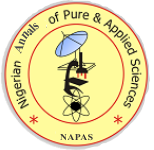Comparative Study of Bioethanol Yield from Selected Agro-waste Feedstocks Using Fermentative Saccharomyces Cerevisias
Abstract
Bioethanol is a biofuel produced from renewable biological sources that is currently used in many countries as a safer substitute for fossil fuels. This study investigated the potential of rice husk, cassava, potato and yam peels as biomass for bioethanol production using Saccharomyces cerevisiae. The feedstocks were pre-treated with 50 mL of 0.1 M HCl at 50 ºC for 20 min and hydrolysed at 100ºC with 100 mL of 2 M HCl. Thereafter, the pH of the samples was adjusted using equal conc. of NaOH and fermented using 10 g of Saccharomyces cerevisiae for 96 h. It was then distilled at 81 – 83
ºC. The result showed that the dissolved sugar concentration was significantly higher in potato peels than in yam peels (P = 0.004) and cassava peels (P = 0.045) but insignificant compared to rice
husk (P = 0.158). However, the concentration of ethanol produced from rice husk (11.74±6.01% (v/v)) was slightly higher than potato peels (9.75±1.77% (v/v)); cassava peels (5.00±3.53% (v/v)) and yam peels (4.00±4.96% (v/v)), with no significant difference between them (P>0.05). Further investigation showed that, only 47.96% of the hydrolysate from rice husk, 39.06% from cassava peels, 33.27% from yam peels and 25.41% from potato peels were converted to ethanol and other by-products. The selected feedstocks showed good potential for bioethanol production especially the rice husk, and as
such; commercial production is recommended for effective utilization and downstream applications
References
Amuta, E., Moumson, R. and Mker, S. (2008). Impact of Demographic and Economic factors
on the prevalence of intestinal parasites among the female gender in Makurdi, Nigeria. The
internet journal of third world medicine, 8(2)
Binod, P., Raveendran, S., Reeta, R.S., Surender, V., Lalitha, D and Satya, N. (2010).
Bioethanol production from rice straw: An overview. Bioresource Technology,
:4767–4774.doi: https://doi.org/10.1016/j.biortech.2009.10.079
Braide, W., Kanu, I.A., Oranusi, U.S. and Adeleye, S.A. (2016). Production of Bioethanol
from Agricultural Waste. Journal of Fundamental and Applied Sciences, 8(2), 372-386.doi:
https://doi.org/10.4314/jfas.v8i2.14
Braide, W., Oji, I.N., Adeleye, S.A. and Korie, M.C. (2018). “Comparative study of
bioethanol production from agricultural wastes by Zymomonasmobilis and Saccharomyces
cerevisiae”. International journal of applied microbiology and biotechnology research, 6:50-
Busic, A., Mardetko, N., Kundas, S., Morzak, G., Belskaya, H., Santek, M.I, et al. (2018).
Bioethanol Production from Renewable Raw Materials and its Separation and Purification: A
Review. Food Technology and Biotechnology, 56(3):289-311.
doi:https://doi.org/10.17113/ftb.56.03.18.5546
Ellen, L.D. (2001). The Alcohol Fuel Handbook. Haverford Publishers,
infinitypublishing.com.
Ezejiofor, T.I.N., Enenebeaku, U.E., Enenebeaku, C.K., Nwankwo, M.U. and Ogbonnaya,
C.I.A. (2018). “Comparative study of bio-ethanol yield from yam, potato, watermelon, and
pineapple peels using different concentrations of hydrochloric acid”. World news of natural
sciences (WNOFNS), 16:18-32.
Fakuddin, M.D., Ariful, I., Monzur, M.A. and Nayuum, C. (2012). Process optimization of
Bioethanol production by stress tolerant yeast isolated from agro-industrial wastes.
International Journal of Renewable and Sustainable Energy, 2(4):133-139.
Food and Agriculture Organization (FAO)(1999). Roots, Tubers, Plantains and Banana in
human nutrition. Vol. 24 of Food and Nutrition series, Food and Agriculture Organization,
Rome, Italy.
Gould, J.M. and Freer, S.N. (1984). High-efficiency ethanol production from lignocellulosic
residues pretreated with alkaline H 2 O 2 . Biotechnology and Bioengineering, 26:628–631.
Hoang, T. and Nghiem, N. (2021). Recent developments and current status of commercial
production of fuel ethanol. Fermentation, 7(4):314.
Hossain, Z., Golam, F., Jaya, N.S., Mohd, S.A, Rosli, H. and Amru, N.B. (2014). Bioethanol
Production from Fermentable Sugar Juice. Scientific world journal, 2014:957102.
Khongsay, N., Laopaiboon, L. and Laopaiboon, P. (2010). Growth and batch fermentation of
Saccharomyces cerevisiaeon Sweet Sorghum stem juice under normal and high gravity
conditions. Biotechnology, (1):9-16.
Konstantinos, D., Thomas, P., Argiro, L., Konstantinos, G., Angelos, A.L. and Nikolaos, P.
(2019). Effect of various pretreatment methods on bioethanol production from Cotton stalks.
Fermentation, 5(5):2-12
Lee, S., Speight, J.G., Loyalka, S.K, editors (2007). Handbook of Alternative Fuel
Technologies. CRC Press, Boca Raton, FL, USA.
doi:https://doi.org/10.1201/9781420014518
Manas, R. S., Ajit, S., Ajay, K. S. and Deepak, K. T. (2016). Bioethanol Production from
Rice and Wheat Straw: An Overview. Ethanol as bioenergy resources, 11:213-231.doi.
https://doi.org/10.1016/B978-0-12-813766-6.00011-4
Martín, C., Galbe, M., Wahlbom, C.F., Hahn-Hägerdal, B. and Jönsson, L.J. (2002). Ethanol
production from enzymatic hydrolysates of sugarcane bagasse using recombinant xylose-
utilizing Saccharomyces cerevisiae. Enzyme and Microbial Technology, 31:274–282.
Mussatto, S.I., Dragone, G., Guimarães, P.M.R., Silva, J.P.A., Carneiro, L.M. and Roberto,
I.C. (2010). “Technological trends, global market, and challenges of bio-ethanol production”.
Biotechnology Advances, 28(6):817–30. doi: dio:
https://doi.org/10.1016/j.biotechadv.2010.07.001
Nutawan, Y., Phattayawadee, P., Pattranit, T. and Mohammad, N.E. (2010). “Bio-ethanol
Production from Rice Straw”, Energy Research Journal, 1(1):26-31.
Paniagua-Michael, J. (2015). Bioremediation with microalgae: Toward sustainable
production of Biofuels. Biotechnology Advances, 2015:471-48. doi:
https://doi.org/10.1016/B978-0-0-12-800776-1.00031-5
Sirajo, I.I., Muhammad, I.A. and Mominur, R. (2019). “Comparative study on the production
of Bioethanol from Banana and Yam peel.”Pharmarcology online, 1:100-106.
Tomás-Pejó, E., Alvira, P., Ballesteros, M. and Negro, M.J. (2011). “Pretreatment
Technologies for Lignocellulose-to-Bioethanol conversion”. In: Busic A, Mardetko N,
Kundas S, Morzak G, Belskaya H, Santek M.I, et al. Bioethanol Production from Renewable
Raw Materials and its Separation and Purification: A Review. Food Technology and
Biotechnology, 2018;56(3):289-311. doi:
https://doi.org/10.17113/ftb.56.03.18.5546
Wi, S.G., Seong, C., Kyoung, H.K., Ho, M.K. and Hyeun-Jong, B. (2013). “Bioethanol
production from rice straw by popping pretreatment”, Biotechnology for Biofuels, 6:166.
Downloads
Published
How to Cite
Issue
Section
License
Copyright (c) 2023 Odeh, P. I., Ogwuche, S., Adoga S. O., Onoja J. F, Utume L. N.

This work is licensed under a Creative Commons Attribution-ShareAlike 4.0 International License.



 Contact Us
Contact Us Editorial Team
Editorial Team Join As A Reviewer
Join As A Reviewer  Request For Print Copy
Request For Print Copy


 Cprint Publishers
Cprint Publishers